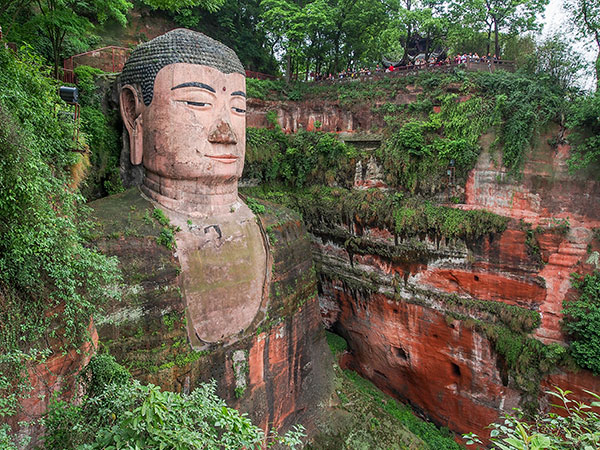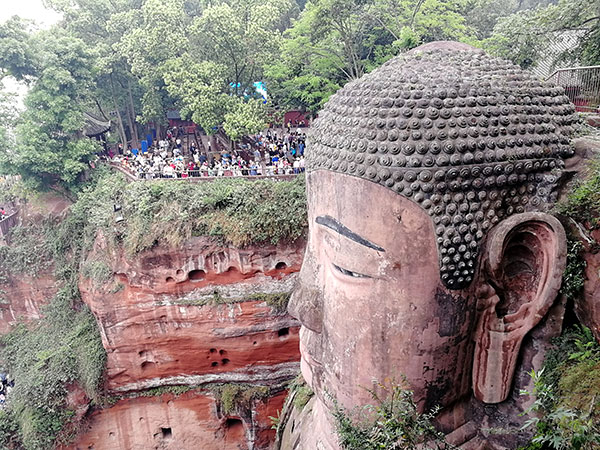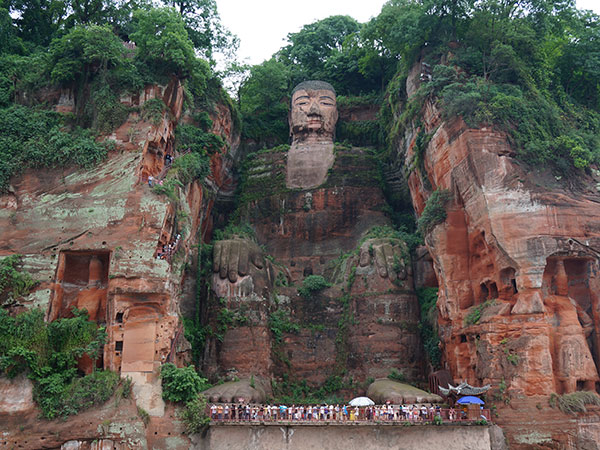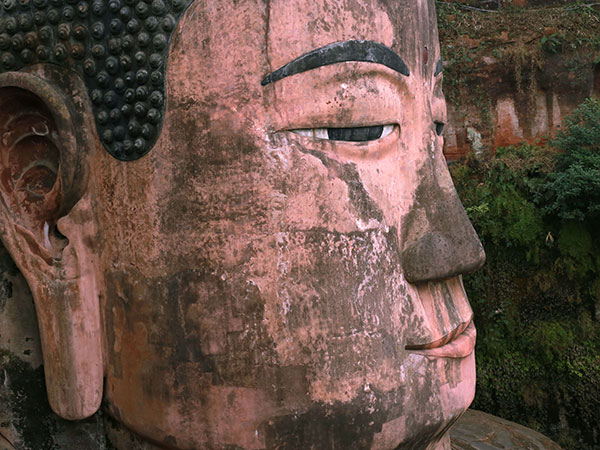 Ask a Question
Ask a QuestionLingyun Road, Leshan, Sichaun Province.
The largest Maitreya Buddha in the world, the biggest and tallest stone Buddha statue in the world
Also named: Lingyun Giant Buddha
Chinese name: 乐山大佛
Height: 71 meters (233 feet)
Began to be built in the year of 713, and finished in 803
Entrance fee: CNY 90 per person (including Wulong Temple & Mahao Cliff Tomb)
Leshan Giant Buddha boat trip ticket price: CNY 70 per person

Leshan Giant Buddha is the tallest stone Buddha statue in the world, which was carved out of a cliff on Lingyun Mountain. Leshan Giant Buddha, together with Mount Emei Scenic Area, was listed by UNESCO as the World Cultural and Natural Heritage in 1996.. The Giant Buddha lies at the junction of the Minjiang River, Dadu and Qingyi Rivers. The stone sitting sculpture faces the sacred Mt. Emei, with the rivers flowing below his feet. Construction on the Giant Buddha began in 713 A.D during Tang Dynasty. It was the idea of a Chinese monk named Haitong, who hoped that the Buddha would calm the turbulent waters that plagued the shipping vessels travelling down the river. The rock and mud excavated from the mountain exposing the Buddha filled up the riverbed, creating a more favorable flow of water. Consequently the river did become calmer.
The statue depicts a seated Maitreya Buddha with his hands resting on his knees. Maitreya is the future Buddha, who will appear to preach the dharma when the teachings of Gautama Buddha have faded away. Maitreya was especially popular during the 4th to 7th centuries, and his images were found throughout the Buddhist world, conveying his characteristic air of expectancy and promise.
There is smart drainage system on Leshan Giant Buddha. Several drainage passages are hidden in the Buddha's hair, collar, chest, and holes in the back of his ears and chest, preventing the Buddha from serious erosion and weathering. He has also been lovingly maintained on a regular basis throughout his 1,200-year history.

Leshan Giant Buddha is a statue of maitreya. People worship maitreya in Tang dynasty. Buddhist texts wrote that the world would be "in peace" when maitreya was born. During Wuzhou Period (690-705), Wu Zetian gave orders to make up a book to prove she was the maitreya reincarnation. With the help of worship of the maitreya, she became the first woman emperor in feudal times of China. Since Wu Zetian strongly advocated maitreya, carving Buddha prevailed among the whole country. The Leshan Giant Buddha began to be built only 20 years from Wu Zetian Period, therefore the craftsman chose to carve maitreya in the mountain. Besides, maitreya is Buddha that can bring light and happiness of the future. This meaning was in accordance with the claim of quieting down the flood.
The Buddha is so huge that everything is big on his body. He has a 14.7-meter-tall (48.2 ft), 10-meter-wide (32.8 ft) head, 7-meter-long (23 ft) ears, a 5.6-meter-long (18.3 ft) nose, two 5.6-meter-long (18.3 ft) eyebrows, 3.3-meter-wide (10.8 ft) eyes and mouth, a 3-meter-long (10 ft) neck, 8.3-meter-long (27.2 ft) fingers and 8.5-meter-wide (27.9 ft) feet that can accommodate more than 100 people sitting together.

The Buddha began to be carved in the first year of Kaiyuan Period of the Tang dynasty (713), and completed in Zhenyuan Period nineteenth years (803), about ninety years in all to finish it. The construction of Leshan Giant Buddha was a long and tortuous process. When it was built on the shoulder part, Monk Haitong died, and then the construction was suspended. Several years later, Haitong’s apprentice led the craftsman to continue the work on the Buddha, with the help of government payment and the donation from Qiu Jianqiong, a local official in Sichuan. However, the construction was stopped again when the Buddha was built on the knee part, as Qiu Jianqiong was promoted and moved to Beijing. It wasn’t restarted until 40 years later when another Sichuan local official Wei Gao donated for Leshan Giant Buddha. This time it was finally completed.

In addition to the Buddha, travelers can also visit Lingyun Temple, Lingbao Pagoda, Mahao Cliff-tomb on the mountain and experience the Nine-bend Lingyun plank Road on the right side of the Buddha. Besides, you are also encouraged to take a boat trip on the river to have a full view of Leshan Giant Buddha.
On both sides of big Buddha cliffs and mountain road, there are many stone grottoes statues, most of them are the works in glorious age of Tang dynasty. In the right side river of Lingyun Temple, there is a 2-foot-tall tower of 13 floors. The modeling is similar to Xi'an Small Wild Goose Pagoda. In the left river side of Temple, there is a solo peak standing upright, namely Wuyou. Nearby it is Wuyou Temple built in Tang dynasty.

Spring and autumn is the best season. In spring all flowers bloom together, the sea cloud on the top of the mountain is the most beautiful; In May and June, at the foot of mountain the weather is sunny but the top of mountain is rainy; Autumn it's sunny, the climate is suitable when is a good time to watch the sea of clouds, sunrise and sunset at the top of the mountain; In winter the temperature is low but still have clear weather.
Vantage Point: the most suitable viewing place is in the front of the Giant Buddha, tourists can appreciate full view of Giant Buddha by boat.
From Leshan city center: Passengers can take bus No.3 and No.13 to the scenic area of Leshan Giant Buddha. Or you can take a taxi.
From Leshan Train Station: Get on bus No.3 and get off at Dafosi Station. It takes around 1 hour and the bus fare is CNY 1.
From Mout Emei: There are sightseeing buses from Mount Emei to Leshan Giant Buddha.